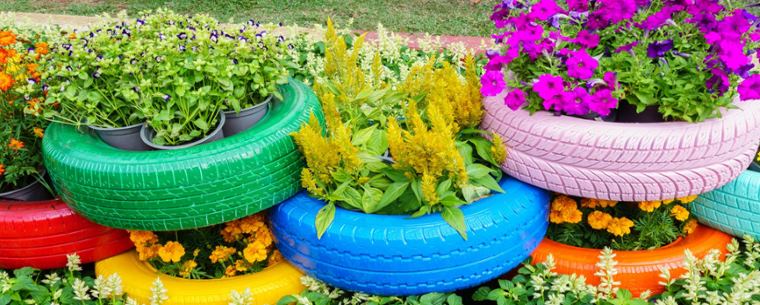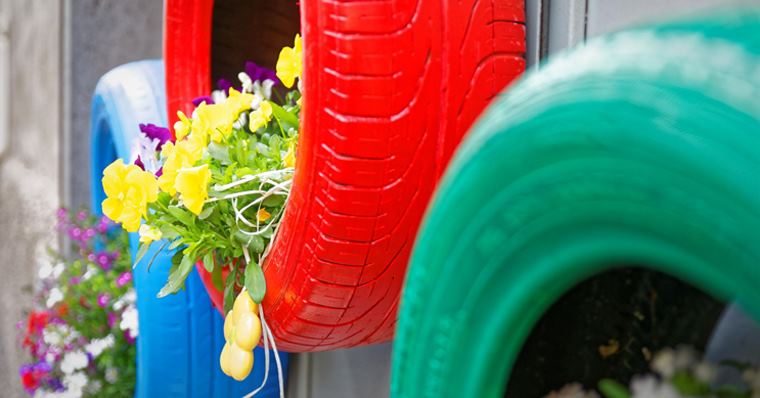How to make a DIY tyre planter
Kwik Fit | Friday 30th August 2019 4:45pm

At Kwik Fit, weíre always trying to do our bit for the environment. Did you know that we can turn your old tyres into carpet underlay, playground surfaces, laminate flooring, or sports pitches? You can find out more about our recycling efforts here. But what if you wanted to keep your old tyres* to make something beautiful with them?
If you want to keep your tyres, you could turn them into seating, build an obstacle course, or even make a dog bed. There are plenty of ideas online on how to reuse your tyres. Thatís why weíve brought you this post all about how to turn your tyre into a garden planter. Use our guide to make one for your own garden.
How to make a tyre planter
The first step is to make sure that your tyre is clean. Youíre going to be painting it, so youíll want to remove as much dirt and mud from the tyre as you can. Use a hose to get the worst of the dirt off, then use a damp cloth to get into the tread grooves.
Once your tyre is dry, itís time to paint it. Painting the tyre will hugely affect the overall look, so be really creative with this step. You could choose bright colours, such as royal blue or a bold red, or you could go for muted colours such as a pastel green or white. And you donít just have to stick to one colour. You could add a pattern or even draw an image onto the tyre. Whatever you do, make sure you paint a thick layer around the whole tyre. You may even want to paint the inside as the black rubber may still be visible in places when the plants are in.
If youíre being creative, you could paint the inside of the tyre a different colour to the outside. Once youíve painted your tyre and made sure that youíve covered the whole surface, let it dry for at least a few hours.
Once itís dry, your tyre is ready for planting. You should move your tyre to its permanent location, as it will be almost impossible to move once youíve filled it. When youíre happy with its position, you will need to line the tyre.
How to line your tyre planter
If youíre laying your tyre on the floor and filling it, we would advise that you line it first. When youíre lining your planter, you want to use a material that allows water to drain through, or youíll need to create drainage holes. You could use a sheet of plastic of a piece of hessian material. If you choose to use hessian, you can secure it in place with a staple gun. The hessian allows the water to drain efficiently so your plants donít drown. If you choose to use a plastic sheet, poke a few holes in it using a screwdriver before you secure it to prevent water from sitting in the bottom of the planter.
The lining doesnít have to be secured - it can sit at the bottom of your tyre instead. Just make sure that you donít want to move your tyre planter once itís finished, as everything could fall out of the bottom.
If youíre going to hang your tyre against a wall, you wonít need to line it. You can put your soil and plants straight onto the rubber, though you may need to drill some holes for water drainage.

How to hang your tyre planter
If youíre planning to hang your tyre like a hanging basket, you can do this easily yourself. First, you need to buy an industrial hanging hook. Ensure that the hook is wide enough for the whole tyre to sit on and that the hook can hold the tyreís weight (usually between 10 and 15kg) as well as the weight of the soil and plants when theyíre wet.
Then, decide on a place for your hanging tyre planter. Screw your hanging hook into the wall, checking that itís secure. Hang your tyre onto the hook and check youíre happy with the position.
How to grow plants in tyres
Once youíve lined the planter with your chosen material, and hung the tyre if required, you can begin to add your plants and soil. First, you should put in some drainage stones or pebbles, then add your compost or soil on top.
If your tyre is being hung on a wall, you should fill it as you would a hanging basket. Itís a good idea to use brightly coloured plants that will trail down the wall. Some popular hanging basket plants include calibrachoa, lobelias, begonias, and petunias.
If your tyre will be laid down on the floor, then you should fill it as you would a plant pot. Perennials or small shrubs are best suited for a tyre planter. A large plant or shrub might not be able to grow in a tyre because it wonít be able to dig its roots very deep. Plants that might work best include cyclamen, pansies and chrysanthemums.
The plants that are best suited for a tyre planter are perennials or small shrubs. Perennials such as cyclamen, pansies and chrysanthemums will work well. For some evergreen foliage, add a hosta plant. Remember to give your flowers plenty of water to prevent the soil from drying out too much.
You could build your tyre planter collection until you have multiple tyres in different colours and all filled with different plants. If you create one, weíd love to see the results. You can tag us on Twitter at @Kwik_Fit or Facebook at @KwikFit.
* Note: A tyre disposal fee is automatically included in the price of your new tyres. If you request to keep your old tyres, this fee cannot be refunded.
Any facts, figures and prices shown in our blog articles are correct at time of publication.
Featured Articles
Is it Illegal to Drive With One Headlight?
Saturday 19th July 2025
Wondering if itís illegal to drive with one headlight? Learn about the safety risks and penalties of illegal blown bulbs and why you should fix them promptly.
Air Con in EVs & Hybrids: Experts Answer Your Questions
Monday 30th June 2025
Does air con drain EV batteries? Can you use the air con while charging an electric car? Find out the answers to these questions & more from Kwik Fitís experts.
Why Is Your Car Making a Noise? Fixes & Tips
Friday 13th June 2025
When your car starts making unexpected noises, it can certainly be quite disconcerting; it may be nothing to worry about, but hereís what you need to know.









